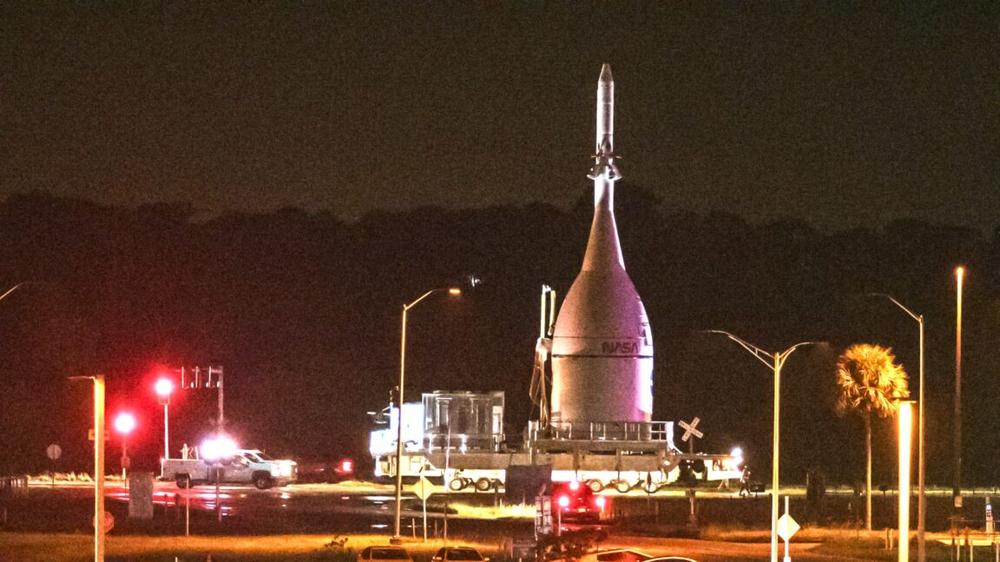The Orion spacecraft, which will fly four people around the Moon, arrived inside the cavernous Vehicle Assembly Building at NASA’s Kennedy Space Center in Florida late Thursday night, ready to be stacked on top of its rocket for launch early next year.
The late-night transfer covered about 6 miles (10 kilometers) from one facility to another at the Florida spaceport. NASA and its contractors are continuing preparations for the Artemis II mission after the White House approved the program as an exception to work through the ongoing government shutdown, which began on October 1.
The sustained work could set up Artemis II for a launch opportunity as soon as February 5 of next year. Astronauts Reid Wiseman, Victor Glover, Christina Koch, and Jeremy Hansen will be the first humans to fly on the Orion spacecraft, a vehicle that has been in development for nearly two decades. The Artemis II crew will make history on their 10-day flight by becoming the first people to travel to the vicinity of the Moon since 1972.
Where things stand
The Orion spacecraft, developed by Lockheed Martin, has made several stops at Kennedy over the last few months since leaving its factory in May.
First, the capsule moved to a fueling facility, where technicians filled it with hydrazine and nitrogen tetroxide propellants, which will feed Orion’s main engine and maneuvering thrusters on the flight to the Moon and back. In the same facility, teams loaded high-pressure helium and ammonia coolant into Orion propulsion and thermal control systems.
The next stop was a nearby building where the Launch Abort System was installed on the Orion spacecraft. The tower-like abort system would pull the capsule away from its rocket in the event of a launch failure. Orion stands roughly 67 feet (20 meters) tall with its service module, crew module, and abort tower integrated together.
Teams at Kennedy also installed four ogive panels to serve as an aerodynamic shield over the Orion crew capsule during the first few minutes of launch.
It was then time to move Orion to the Vehicle Assembly Building (VAB), where a separate team has worked all year to stack the elements of NASA’s Space Launch System rocket. In the coming days, cranes will lift the spacecraft, weighing 78,000 pounds (35 metric tons), dozens of stories above the VAB’s center aisle, then up and over the transom into the building’s northeast high bay to be lowered atop the SLS heavy-lift rocket.
Workers will methodically tighten 360 bolts to firmly connect the Orion spacecraft to the Space Launch System. Once complete, NASA will have the 322-foot-tall (98-meter) rocket and spacecraft for Artemis II fully assembled for final tests and checkouts inside the VAB, the same structure used to ready space shuttles and Moon-bound Apollo missions for flight in past eras of human spaceflight.
The path ahead
One of the most critical activities planned in the VAB is a countdown rehearsal with the four-person Artemis II crew. The astronauts will take their seats inside the Orion spacecraft and practice their launch-day procedures, which include configuring the craft’s cockpit for flight. The rocket won’t be fueled for this event.
Other tasks planned for the rest of the year include testing of the rocket’s destruct system, which would be used if the vehicle flies off course after liftoff. NASA will then be ready to roll the SLS rocket and Orion spacecraft to Launch Complex 39B, probably sometime in January if the mission holds to its February 5 target launch date.
At the pad, NASA will run the rocket through a practice countdown. This time, the rocket will be fueled with super-cold liquid hydrogen and liquid oxygen to make sure everything is in good shape for launch day. This is the same test that uncovered persistent hydrogen fuel leaks on the SLS rocket before the first unpiloted Artemis test flight in 2022.
Charlie Blackwell-Thompson, NASA’s Artemis II launch director, said last month that officials believe the hydrogen leak problem has been “put to bed” after changing the design of a leaky valve and demonstrating a gentler fueling procedure during the Artemis I countdown three years ago.
If the countdown rehearsal goes well, the launch team and rocket will be ready for the real launch attempt a few days later. Officials don’t plan to return the rocket to the VAB unless they uncover a major problem at the pad.
On launch day, Wiseman and his three crewmates will take their seats inside the Orion spacecraft a few hours before liftoff. Their ride to space will push them off the pad with 8.8 million pounds of thrust. A few minutes later, the Launch Abort System will jettison to reveal the Orion crew capsule. Once in orbit, Orion will break free of the rocket, and if everything looks good, they’re off to the Moon.

 Ball x Pit evolution tier list
Ball x Pit evolution tier list